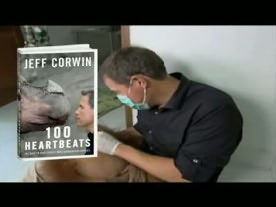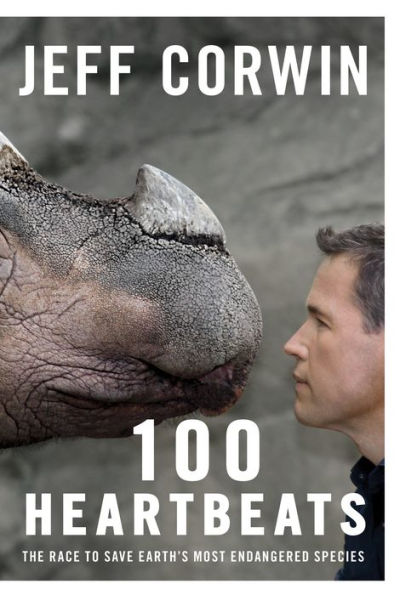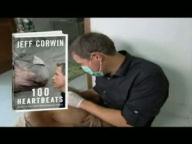

eBook
Related collections and offers
Overview
In 100 Heartbeats, conservationist and television host Jeff Corwin provides an urgent, palpable portrait of the wildlife that is suffering in silence and teetering on the brink of extinction. From the forests slipping away beneath the stealthy paws of the Florida panther, to the giant panda's plight to climb ever higher in the mountains of China in search of sustenance, to the brutal poaching tactics that have devastated Africa's rhinoceros and elephant populations, Corwin takes readers on a global tour to witness firsthand the critical state of our natural world. Along the way, he shares inspiring stories of battles being waged and won in defense of the earth's most threatened creatures by the conservationists on the front lines.
These stories of hope and progress underscore an important message: Our own survival, as well as that of the world's wildlife, is in our hands. The race to save the planet's most endangered wildlife is under way. Every heartbeat matters.

Product Details
| ISBN-13: | 9781605293240 |
|---|---|
| Publisher: | Harmony/Rodale |
| Publication date: | 10/27/2009 |
| Sold by: | Random House |
| Format: | eBook |
| Pages: | 320 |
| File size: | 2 MB |
About the Author
Read an Excerpt
Chapter 1
THE RACE AGAINST EXTINCTION
FROM THE HELICOPTER, I can see an endless stretch of Arctic ice. The downward curve of the horizon in the distance lets me know that I'm as close to the top of the world as I've ever been.
The landscape is otherworldly--starkly desolate and yet shockingly beautiful. I'm with Steve Amstrup, senior polar bear scientist with the US Geological Survey's Alaska Science Center, flying above the ice-locked village of Kaktovik, 300 miles north of the Arctic Circle.
We're searching for the mighty polar bear (Ursus maritimus), the apex predator that presides over the Arctic food chain. Spotting bear tracks as the snow blows across the ice is very difficult, so the pilot takes the chopper lower in an attempt to give us a better chance. I can see cracks and larger openings called leads in the ever-shifting labyrinth of ice. All day every day, millions of tons of ice are churned, crushed, and reconfigured. Cliffs form and leads open like gaping jaws. Wind scours the snow from the tundra, revealing silvery ice mirrors that intermittently blind us with the sun's reflection. We'd never survive on this ice, but polar bears can't survive without it.
Eric Regehr, another research scientist on Steve's polar bear team; my cameraman, Glenn Evans; and my sound guy, Jonah Torreano, are also on board. We're all excited when Steve points to the east and says, "There!" The pilot follows the tracks for nearly 30 miles before we finally catch our first glimpse of an enormous female running across the ice with her two young cubs, all 500 £ds of her massive body undulating beneath a layer of snowy white fur. The family is nearly invisible against the white backdrop of bluish white ice, and their camouflage is further enhanced by the sunlight bouncing off the ground. Even with my sunglasses on, I can feel a powerful headache coming on from the glare.
As the chopper closes the distance between us and the bears, they begin galloping at close to 20 miles per hour to escape what the mother perceives to be a giant flying predator. The female, who could run much faster if she wasn't being held back by her tiny offspring, doesn't know, of course, that the helicopter carries scientists who have devoted their lives to protecting her species. But despite her instinct to escape, she doesn't abandon her cubs. Even as the whirling cloud of snow created by the helicopter threatens to engulf her, she stops and allows them to catch up with her.
Steve loads a tranquilizer dart into his rifle, slides open the clear plastic window, and takes aim. Pop! The rifle fires as ice particles are sucked through the open window and prick our faces. It's a perfect shot, and within minutes the mother bear begins to slow and then sway drunkenly as she succumbs to the sedative. Steve takes a deep breath and sighs with relief, knowing that the data he gathers today can be added to the body of knowledge being used to conserve her species.
The familiar thrill of adventure rushes through my veins as I carefully step out onto the flat patch of snow-covered ice. I'm wearing $1,000 worth of high-tech, subzero weatherproof clothing, but with the -20°F temperature made even more frigid by the biting wind, I feel naked and helpless. The membranes of my eyes sting, and my breath instantly forms icicles on my face mask. Within minutes, the muscles in my face and lips begin to freeze, and when I speak I sound as if I, too, have been hit by a tranquilizer dart. But my inner adventurer loves every second of this experience, even the discomfort. I think back to the story I learned in fifth grade about the brave commander Robert E. Peary reaching the North Pole for the first time in 1909.
I've always been inspired by the accomplishments of other explorers and scientists. As a conservationist, I cherish the opportunity to be on the front lines in the race to save Earth's creatures. And as a biologist, I'm humbled by the fellowship of scientists joining together to make a critical difference in our uncertain future. Steve Amstrup is arguably one of the world's leading experts on polar bears. That he welcomed me to come on this research expedition is a great honor and privilege.
The pilot hands us our gear, and Steve rushes forward to the sow as Eric and I run after the cubs. We need to capture them and inject them with a mild sedative so that we'll be able to take measurements and then mark and tag them. But more importantly, we need to make sure they aren't separated from their mother. Polar bear cubs are dependent on their mothers until they're 2 1/2 years old.
The young cubs don't make this an easy task, though, bolting away from us in single file. We sprint after them across the perilous ice, crossing the enormous tracks their mother left in the snow. Polar bear paws can measure 12 inches across and are wide enough to wrap around a man's head--and strong enough to crush it as easily as if it were an egg. Full-grown females weigh between 450 and 750 £ds; adult males are usually twice as heavy.
When I finally grab the first cub, scooping it up in my arms, I feel a little like I'm dreaming--I can't believe I'm holding a polar bear cub in its own habitat. Eric catches the other cub, and we gently inject them with sedatives, then tread--slowly and carefully this time--back across the treacherous landscape to reunite with Steve. We place the cubs next to their mother, and I sit on the ground to help Steve loop the radio collar around her neck. Steve has made sure she is lying in a safe position, snout pointed up and away from the ice; if she were lying facedown, she could suffocate in the snow and ice around her face.
Soon after we measure and mark the cubs, they begin to wake up and stretch. This time, they don't run from us. With the chopper still and silent, we simply appear to them to be some bipedal species that's significantly smaller than their mother. Having never encountered humans before, they have no reason to fear us, so they nuzzle us as they seek security and comfort. This is one of thosemoments when I understand how easy it is for people to anthropomorphize, projecting human feelings and qualities onto the instinctive behaviors of animals. Like other "poster animals" for endangered species--such as pandas, sea otters, and tiger cubs--the fluffy, white polar bear cubs, with their dark, round eyes and black button noses, evoke in us a strong emotional reaction to protect them as if they were our own children. Although I'm well aware that these are wild animals with sharp claws and teeth even at a young age, seeing them in this vulnerable state, without their mother's protection, instinctively tugs at my heart. I want them to live long and healthy lives in their natural habitat. In this moment, I don't allow my mind to dwell on the difficult future these cubs are destined to endure as their home melts away beneath their paws. There will be time enough to ponder these sobering thoughts when we return to the research lab, after our work here is finished.
For these precious 40 minutes, I honor the power and presence of these great white bears by being of service to one of their champions. With the considerable weight of the sow's massive head pressing into my lap, I pull off the magnetic switch on the radio collar so it begins transmitting the signal that will allow Steve to track her movements. All the while, I'm reveling in this once-in-a-lifetime experience, indelibly etching each moment into my memory.
This is the second trip I've made to Kaktovik to work with Steve. The first was while filming Planet in Peril in April 2007. Now, it's April 2008 and I'm filming a special for Animal Planet. Steve has been working with polar bears for 28 years. He understands these marine mammals better than anyone I've encountered, and he's gravely concerned about their future.
During the summer of 2008, Arctic sea ice receded to record levels--levels that 50 percent of climate modelers predicted wouldn't happen until 2050. Although the 2008 world population of polar bears is estimated to be more than 20,000, if Earth continues to warm at its current rate, forecasts developed by Steve's team at the US Geological Survey suggest that two- thirds of the polar bear's habitat will disappear by 2050. The bears would vanish from Alaska, Europe, and Asia. Their numbers and distribution also would decline in the Arctic Archipelago of Canada (the channels between the country's high Arctic islands) and areas off the northern coast of Greenland. By 2080, they would completely disappear from all of their current range except the Arctic Archipelago and the adjacent continental shelves north of these islands. Even there, populations would probably be reduced.
"It's clear from all of the available research that the main threat to polar bears is the loss of their habitat as the result of global warming and that the global warming is being caused by increases in greenhouse gases. In fact, you can even take it one step beyond that," Steve says. "We know that the laws of physics dictate that more greenhouse gases in the atmosphere will lead to a warmer world. There are still going to be fluctuations in the climate--changes in oceanic circulation and atmospheric circulation can change the local temperatures or even the global mean temperatures, perhaps even for relatively extended periods of time--but whatever those temperatures are, they will be higher than they would have been had it not been for higher concentrations of greenhouse gases. So, to say 'Well, we're going to try to manage polar bears without managing greenhouse gases' is ignoring the larger, fundamental threat."
The polar bear has the unfortunate distinction of being the first animal to be listed as threatened due to climate change and the resulting loss of sea ice. Whereas most animals that are threatened or endangered have lost and continue to lose portions of their natural habitat, the polar bears' case is unique in that the ice itself is their home.
Polar bears have spent their entire evolutionary history adapting to the sea-ice environment. Less than 300,000 years ago, they diverged from brown bears (Ursus arctos) and began adapting to their frigid climate by developing fur on their feet to give them better purchase on the slippery ice. Their huge feet also act like snowshoes when the snow is soft underfoot. And their fur functions as a superefficient insulating and heating system. What look like white outer hairs are actually hollow, transparent tubes that tend to conserve heat. Polar bears are graced with a keen sense of smell--they can trace the scent of a seal that's under 6 feet of snow from a few miles away. They've adapted so well to their icy environment, in fact, that now they can't survive without it.
"They require the surface of sea ice to catch their food," Steve says. "They can come on land to den, and they can come on land to hang out or to cross peninsulas between bodies of water, but all of our data indicate they're only effective at catching prey from the surface of the ice." And as the sea ice diminishes, so, too, does our capacity to secure the survival of this remarkable species. Polar bears hunt mainly where water meets ice, and as that "shoreline" contracts, so do feeding opportunities. When they can't hunt for seals from late summer to late fall because there's no ice, they fast, losing more than 2 £ds a day. And studies in Canada's western Hudson Bay have revealed that these fasts now last about 3 weeks longer than they did 30 years ago.1 This means that they have much less time for the hunting--and eating--that will build up the stores of fat required to sustain them until fall. Once the ice begins to form again, they can resume hunting. And there's one more ramification of the loss of sea ice: Despite the fact that polar bears are excellent swimmers buoyed by thick layers of blubber, scientists expect more bears to drown as the sea ice further recedes. Polar bears have been seen up to 200 miles from land, but the increased need to cross greater and greater expanses of open water raises the odds against them, no matter how well they can swim. It's one of the very cold truths of a warming world.
The plight of the polar bears is a grim reminder that if we don't bring global warming to a halt, even species with large populations face the risk of extinction within decades.
Global Warming -- The Cold, Hard Facts
Polar bears aren't the only species suffering the effects of climate change. One study estimates that global warming will threaten 15 to 37 percent of terrestrial species with extinction by 2050. In India, scientists estimate that between 3 and 32 percent of the 12 most vulnerable Sundarban islands--home to both the world's largest mangrove forest and one of the world's largest Bengal tiger populations--will disappear by 2020 as a result of the rising sea level.2
Arctic sea ice has declined to its lowest levels since we began consistent satellite monitoring in 1979,3 and in September 2007 the Northwest Passage-- a direct shipping route from Europe to Asia through the Arctic Ocean--was ice free for the first time since records have been kept. It may have been a dream come true for mariners, but it was also a sure sign that disaster is closing in. The average global temperature rose 1.3°F from 1906 to 2005, according to the United Nations Intergovernmental Panel on Climate Change (IPCC), which predicts there will be an increase of 3.2° to 7.2°F in this century, depending on how effectively greenhouse gases are curbed.4
Despite conflicting reports you may have heard about whether global warming is actually occurring and whether, if it is, it's our fault, 97 percent of climate scientists surveyed about climate change in 2007 agreed that average global temperatures have increased during the past century.5 Eighty- four percent of those scientists considered the warming to be caused by humans. Only a handful of those surveyed--5 percent--did not believe that human activity contributes to greenhouse warming. Interestingly, 5 percent of those surveyed also said government agencies or public officials have pressured them to "deny, minimize, or discount evidence of human-induced global warming."
Related Subjects
Videos


